+ Open data
Open data
- Basic information
Basic information
| Entry | Database: PDB / ID: 8gha | |||||||||
|---|---|---|---|---|---|---|---|---|---|---|
| Title | Hir3 Arm/Tail, Hir2 WD40, C-terminal Hpc2 | |||||||||
 Components Components |
| |||||||||
 Keywords Keywords | CHAPERONE / Histone / Complex / Replication-Independent | |||||||||
| Function / homology |  Function and homology information Function and homology informationnegative regulation of chromatin organization / HIR complex / negative regulation of transcription by RNA polymerase III / Formation of Senescence-Associated Heterochromatin Foci (SAHF) / transcription elongation-coupled chromatin remodeling / transcription elongation by RNA polymerase II / G1/S transition of mitotic cell cycle / transcription corepressor activity / nucleosome assembly / chromosome ...negative regulation of chromatin organization / HIR complex / negative regulation of transcription by RNA polymerase III / Formation of Senescence-Associated Heterochromatin Foci (SAHF) / transcription elongation-coupled chromatin remodeling / transcription elongation by RNA polymerase II / G1/S transition of mitotic cell cycle / transcription corepressor activity / nucleosome assembly / chromosome / chromatin organization / chromatin remodeling / regulation of transcription by RNA polymerase II / chromatin / negative regulation of transcription by RNA polymerase II / nucleus / cytosol Similarity search - Function | |||||||||
| Biological species |  | |||||||||
| Method | ELECTRON MICROSCOPY / single particle reconstruction / cryo EM / Resolution: 6.8 Å | |||||||||
 Authors Authors | Kim, H.J. / Murakami, K. | |||||||||
| Funding support |  United States, 1items United States, 1items
| |||||||||
 Citation Citation |  Journal: Mol Cell / Year: 2024 Journal: Mol Cell / Year: 2024Title: Structure of the Hir histone chaperone complex. Authors: Hee Jong Kim / Mary R Szurgot / Trevor van Eeuwen / M Daniel Ricketts / Pratik Basnet / Athena L Zhang / Austin Vogt / Samah Sharmin / Craig D Kaplan / Benjamin A Garcia / Ronen Marmorstein / Kenji Murakami /  Abstract: The evolutionarily conserved HIRA/Hir histone chaperone complex and ASF1a/Asf1 co-chaperone cooperate to deposit histone (H3/H4) tetramers on DNA for replication-independent chromatin assembly. The ...The evolutionarily conserved HIRA/Hir histone chaperone complex and ASF1a/Asf1 co-chaperone cooperate to deposit histone (H3/H4) tetramers on DNA for replication-independent chromatin assembly. The molecular architecture of the HIRA/Hir complex and its mode of histone deposition have remained unknown. Here, we report the cryo-EM structure of the S. cerevisiae Hir complex with Asf1/H3/H4 at 2.9-6.8 Å resolution. We find that the Hir complex forms an arc-shaped dimer with a Hir1/Hir2/Hir3/Hpc2 stoichiometry of 2/4/2/4. The core of the complex containing two Hir1/Hir2/Hir2 trimers and N-terminal segments of Hir3 forms a central cavity containing two copies of Hpc2, with one engaged by Asf1/H3/H4, in a suitable position to accommodate a histone (H3/H4) tetramer, while the C-terminal segments of Hir3 harbor nucleic acid binding activity to wrap DNA around the Hpc2-assisted histone tetramer. The structure suggests a model for how the Hir/Asf1 complex promotes the formation of histone tetramers for their subsequent deposition onto DNA. | |||||||||
| History |
|
- Structure visualization
Structure visualization
| Structure viewer | Molecule:  Molmil Molmil Jmol/JSmol Jmol/JSmol |
|---|
- Downloads & links
Downloads & links
- Download
Download
| PDBx/mmCIF format |  8gha.cif.gz 8gha.cif.gz | 264.8 KB | Display |  PDBx/mmCIF format PDBx/mmCIF format |
|---|---|---|---|---|
| PDB format |  pdb8gha.ent.gz pdb8gha.ent.gz | 186.2 KB | Display |  PDB format PDB format |
| PDBx/mmJSON format |  8gha.json.gz 8gha.json.gz | Tree view |  PDBx/mmJSON format PDBx/mmJSON format | |
| Others |  Other downloads Other downloads |
-Validation report
| Summary document |  8gha_validation.pdf.gz 8gha_validation.pdf.gz | 1015.2 KB | Display |  wwPDB validaton report wwPDB validaton report |
|---|---|---|---|---|
| Full document |  8gha_full_validation.pdf.gz 8gha_full_validation.pdf.gz | 1 MB | Display | |
| Data in XML |  8gha_validation.xml.gz 8gha_validation.xml.gz | 41.7 KB | Display | |
| Data in CIF |  8gha_validation.cif.gz 8gha_validation.cif.gz | 64.1 KB | Display | |
| Arichive directory |  https://data.pdbj.org/pub/pdb/validation_reports/gh/8gha https://data.pdbj.org/pub/pdb/validation_reports/gh/8gha ftp://data.pdbj.org/pub/pdb/validation_reports/gh/8gha ftp://data.pdbj.org/pub/pdb/validation_reports/gh/8gha | HTTPS FTP |
-Related structure data
| Related structure data |  40029MC 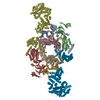 8ghlC 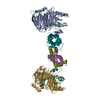 8ghmC 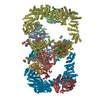 8ghnC 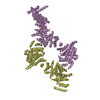 8gixC M: map data used to model this data C: citing same article ( |
|---|---|
| Similar structure data | Similarity search - Function & homology  F&H Search F&H Search |
- Links
Links
- Assembly
Assembly
| Deposited unit | 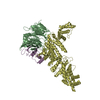
|
|---|---|
| 1 |
|
- Components
Components
| #1: Protein | Mass: 67877.391 Da / Num. of mol.: 1 / Source method: isolated from a natural source / Source: (natural)  |
|---|---|
| #2: Protein | Mass: 191915.188 Da / Num. of mol.: 1 / Source method: isolated from a natural source / Source: (natural)  |
| #3: Protein | Mass: 98553.625 Da / Num. of mol.: 1 / Source method: isolated from a natural source / Source: (natural)  |
-Experimental details
-Experiment
| Experiment | Method: ELECTRON MICROSCOPY |
|---|---|
| EM experiment | Aggregation state: PARTICLE / 3D reconstruction method: single particle reconstruction |
- Sample preparation
Sample preparation
| Component | Name: Hir3 Arm/Tail, Hir2 WD40, C-terminal Hpc2 / Type: COMPLEX / Entity ID: all / Source: NATURAL |
|---|---|
| Molecular weight | Experimental value: NO |
| Source (natural) | Organism:  |
| Buffer solution | pH: 7.6 |
| Specimen | Embedding applied: NO / Shadowing applied: NO / Staining applied: NO / Vitrification applied: YES |
| Vitrification | Cryogen name: ETHANE |
- Electron microscopy imaging
Electron microscopy imaging
| Experimental equipment |  Model: Titan Krios / Image courtesy: FEI Company |
|---|---|
| Microscopy | Model: FEI TITAN KRIOS |
| Electron gun | Electron source:  FIELD EMISSION GUN / Accelerating voltage: 300 kV / Illumination mode: FLOOD BEAM FIELD EMISSION GUN / Accelerating voltage: 300 kV / Illumination mode: FLOOD BEAM |
| Electron lens | Mode: BRIGHT FIELD / Nominal defocus max: 3000 nm / Nominal defocus min: 1000 nm / Alignment procedure: BASIC |
| Specimen holder | Cryogen: NITROGEN / Specimen holder model: FEI TITAN KRIOS AUTOGRID HOLDER |
| Image recording | Electron dose: 42 e/Å2 / Film or detector model: GATAN K3 BIOQUANTUM (6k x 4k) |
- Processing
Processing
| EM software | Name: PHENIX / Version: 1.21_5207: / Category: model refinement | ||||||||||||||||||||||||
|---|---|---|---|---|---|---|---|---|---|---|---|---|---|---|---|---|---|---|---|---|---|---|---|---|---|
| CTF correction | Type: PHASE FLIPPING AND AMPLITUDE CORRECTION | ||||||||||||||||||||||||
| 3D reconstruction | Resolution: 6.8 Å / Resolution method: FSC 0.143 CUT-OFF / Num. of particles: 639629 / Symmetry type: POINT | ||||||||||||||||||||||||
| Atomic model building | Protocol: AB INITIO MODEL / Space: REAL | ||||||||||||||||||||||||
| Atomic model building | Source name: AlphaFold / Type: in silico model | ||||||||||||||||||||||||
| Refine LS restraints |
|
 Movie
Movie Controller
Controller







 PDBj
PDBj

